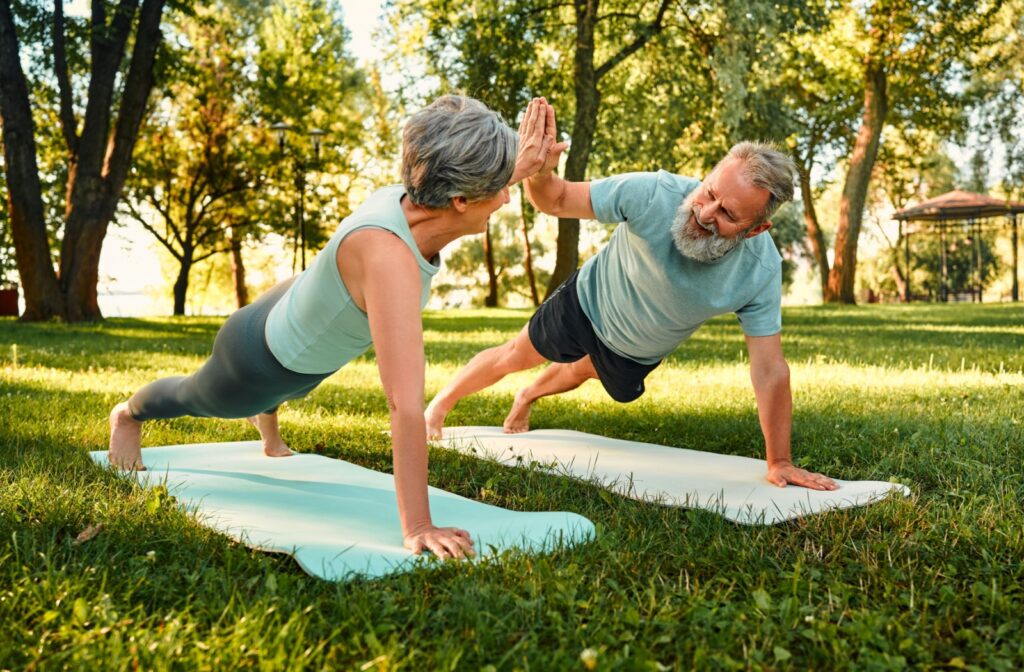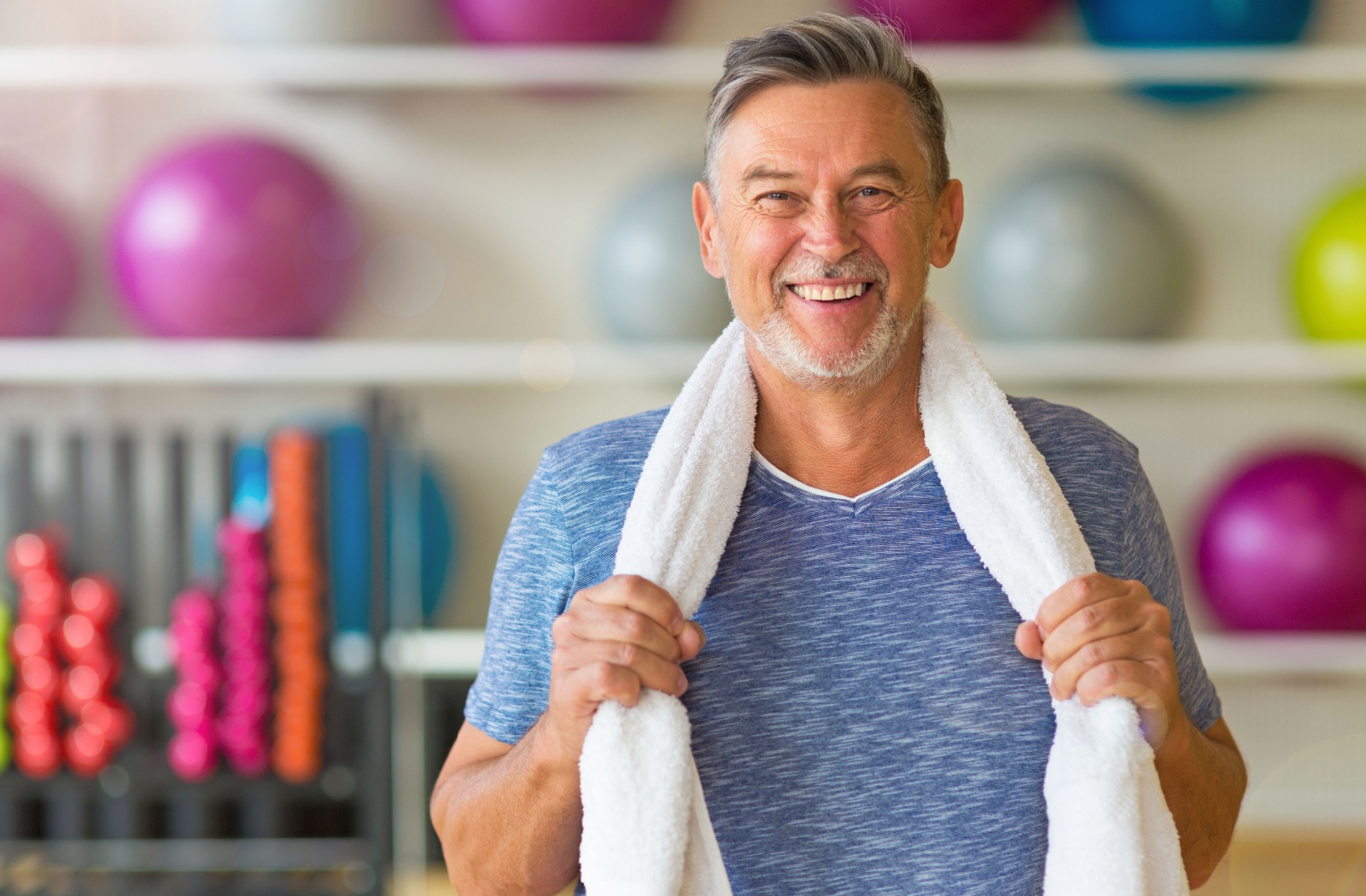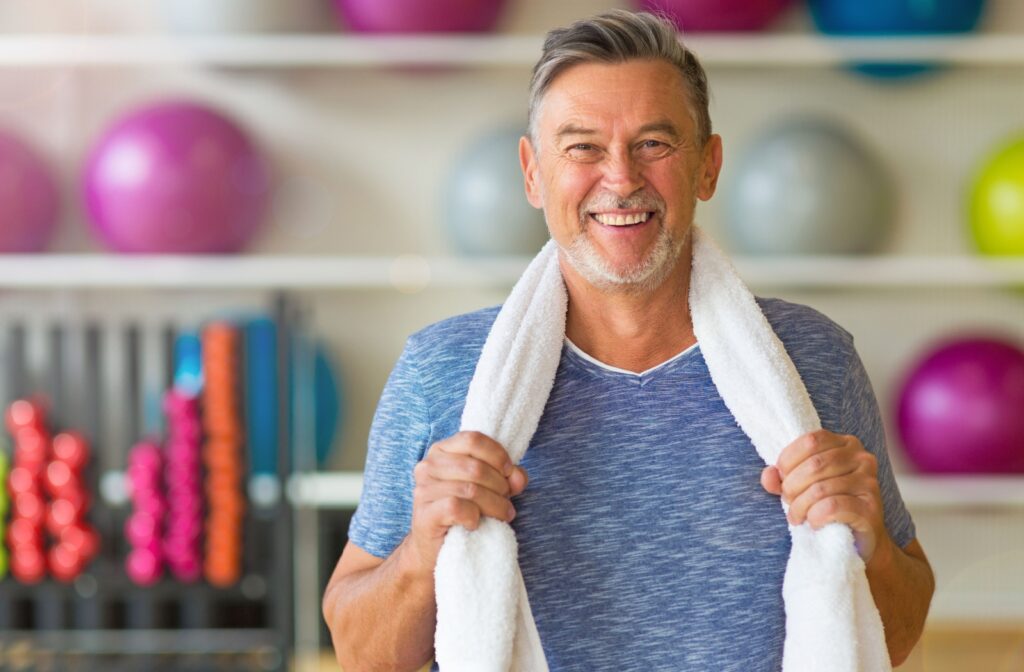Any movement is beneficial, but a well-rounded routine can go a long way toward supporting and improving your overall health and wellness.
The CDC recommends that weekly, older adults should aim for at least:
- 150 minutes of moderate aerobic activity or 75 minutes of vigorous activity
- Two or more days of muscle-strengthening exercises
- Balance exercises at least once a week
Fostering a holistic approach to wellness at All Saints Senior Living includes finding joy in physical movement to help support healthy aging.
Supporting Healthy Aging with Routine Physical Activity
Regular physical activity doesn’t just maintain your health. It enriches your quality of life.
Engaging in routine exercise fosters independence by stimulating mobility and stamina, making everyday activities, like climbing stairs or carrying groceries, easier and more enjoyable.
Practicing movement helps mitigate concerns commonly affecting older adults, such as falls, injuries, and chronic conditions.
The Physical, Emotional, & Cognitive Benefits of Staying Active
We’ve all been told that staying active profoundly benefits our overall health. It’s not only about looking good, it’s about feeling good and caring for our bodies so we can continue to enjoy the things we love.
As we grow older, some areas of our physical health naturally change. Routine activity can help support and maintain these functions, mitigating the risks that come with decreased physical wellness by:
- Supporting joint health: Low-impact exercises like walking or stretching help maintain joint flexibility and reduce stiffness.
- Boosting energy levels: Routine movement can help combat fatigue, promoting a sense of vitality and motivation for daily tasks.
- Increasing bone density: Weight-bearing exercises help build and maintain bone density, reducing the risk of osteoporosis and fractures.
Moving your body is good for your physical health, but it can also be incredible for your emotional well-being in ways such as:
- Reducing stress and anxiety: Physical activity releases endorphins, the body’s natural mood elevators, helping to alleviate stress and reduce feelings of anxiety.
- Boosting confidence: Achieving fitness goals or simply maintaining an active lifestyle can contribute to a greater sense of accomplishment and self-love.
- Encouraging social connections: Group activities such as yoga classes or community walking groups provide opportunities to form relationships, reducing feelings of loneliness or isolation.
- Improving sleep quality: Staying active during the day helps regulate sleep patterns, leading to more restful nights and improved mood during the day.
The brain is one of your body’s most important organs. Routine activity can help support cognitive health, helping your brain feel sharper by:
- Improving brain function: Exercising increases blood flow to the brain, delivering essential oxygen and nutrients that support brain function.
- Improve memory retention: Consistent exercise has been shown to improve memory retention and protect against age-related cognitive decline.
Explore Movement: Fun Physical Activities for Older Adults

Now that we’re familiar with the kinds of activities older adults should incorporate into their routines, let’s explore what these mean and what they can look like.
Aerobic Activity
Better known as cardio, these activities support your heart and lungs by increasing heart rate and respiration, boosting overall endurance.
The beauty of aerobic activity is that you can adjust the intensity of the exercise depending on your strength, mood, and energy levels.
Older adults should focus on doing moderate-intensity exercise at least 150 minutes a week. Some examples of aerobic activities that will increase your heart rate slightly and help you sweat include:
- Dancing
- Gardening
- Walking
Cardio activities are flexible and can be divided into smaller sessions, making it easier to reach your weekly fitness goals. For example, you could aim for 50-minute sessions three times a week or 30-minute sessions five days a week, depending on what fits your schedule.
If you’re looking for a challenge, consider trying vigorous-intensity activities. These require more effort, resulting in heavier breathing and more sweating.
The “talk test” is a great way to gauge how intense your workout is. If speaking becomes harder and you need to pause to catch your breath, that’s a great sign of vigorous intensity.
Because of their demanding intensity, 75 minutes a week for these exercises is a great way to support your cardio health, with activities like:
- Jogging
- Running
- Intense cycling
Strength Training
Strength training targets your muscles using resistance, body weight, or weights. This helps counteract the natural decrease in muscle mass and bone density with age.
Stimulating your muscles isn’t limited to traditional weight lifting. Here are some ways to incorporate strength training into your weekly routine:
- Body weight exercises: These are simple, classic, and don’t require any equipment, making them accessible and versatile. Movements like squats, lunges, and push-ups are effective for targeting major muscle groups.
- Pilates: Focuses on connecting breath with movement for more core control using low-resistance movements and light weights. It helps tone your body, relieve back pain, and improve your posture.
- Traditional weight lifting: This strengthens large muscle groups and boosts overall body strength using dumbbells, barbells, or other weights.
- Barre: Similar to pilates, barre focuses on small, precise movements with low weights and resistance for overall toning and flexibility while building control.
Balance Exercises
Balance exercises are often overlooked, but they improve posture, stability, and range of motion, making complex or unfamiliar movements (such as getting out of the bathtub or stepping off a curb) much safer and easier.
Incorporating balance exercises into your weekly routine can be as simple as practicing standing on one leg while brushing your teeth or washing dishes.
Balance exercises or workouts can include:
- Yoga: A practice of various flow movements to build balance, flexibility, and strength while promoting mind-body alignment through steady movements.
- Tai chi: A gentle, flowing exercise combining slow movements with controlled breathing to promote coordination and mental focus.
- Standing on one foot: Balancing on one leg for a set time, then switching to the other leg to promote even practice.
- Side leg raises: Hold onto a sturdy surface for support as you lift one leg to the side.
Find Joy in Movement
Staying active as you grow older is about tapping into a sustainable lifestyle that celebrates movement as a path to vitality.
Our community at All Saints Senior Living fosters a holistic approach to lifelong wellness, which includes being mindful of physical activity. Connect with us to learn more about our approach to healthy aging.



